Flowing out of Wise View, Wise Intention emerges to establish our internal alignment with this view. In other words, we align our Heart’s aspiration to be in accordance with the understanding of how things are, particularly with respect to the genesis and cessation of suffering.
The Buddha taught that Wise Intention has three components:
- The intention of renunciation, to replace the intention of endlessly pursuing desires.
- The intention of good-will, to replace the intention of animosity and ill-will.
- The intention of harmlessness, to replace the intention of harm.
The first, the intention of renunciation, establishes the conditions for peace within ourselves as we no longer desperately seek abiding fulfillment in transient experiences.
The second and third intentions establish the conditions for peace amongst beings, as the energies of hatred and animosity are supplanted by their wholesome antidotes: lovingkindness and compassion.
Points for Practice
- Within your meditation practice, establish the heart’s resolve to meet each ‘arising’ experience with i. renunciation (letting it be received just as it is) ii. good-will (non-contention) and iii. harmlessness (not trying to get rid of anything)
- For this week, play with ‘renouncing’ something for a period of time that tends to lead to unskillful states. The point is not ascetic purity, but to investigate the energy of desire, itself, with mindfulness. For me, my intention is to stay off the computer until I’ve meditated, exercised and read two chapters of Middlemarch.
Originally published on October 26, 2010

